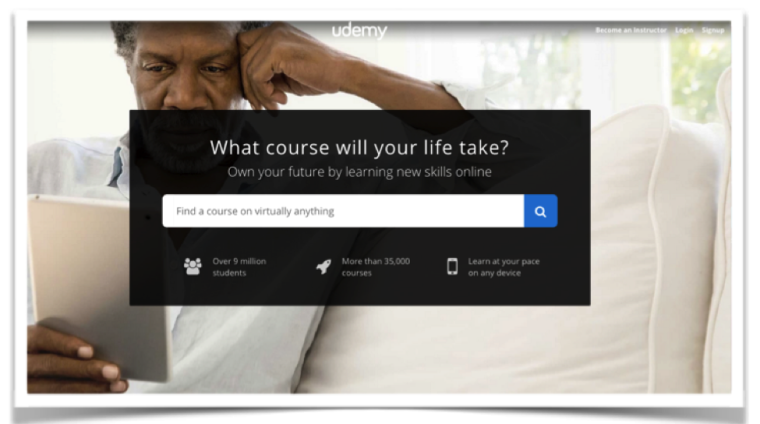You want your Udemy course to be something that people want to engage with, something that they feel is valuable to their own success, and something that’s worth the money.
But that is easier said than done.
Whether you have created a course in the past you want to optimize or are starting fresh, you have to make sure that you have a killer preview, you’re priced right, you’re unique, you’re marketing your course in the right way, and much, much more. The word “easy” doesn’t really apply to creating Udemy courses, but once your course is set to go that word becomes a little bit more prevalent.
Learn some tips on creating a successful course below.
1. Stand Out of the Crowd
Udemy has more than 25,000 courses, so it’s important you stand out to readers. You want to capture users who have purchased other courses and have no interest in repeating (and possibly paying) for the same thing. This is probably the most difficult part of any research, but remember it is part of the job of creating a successful course.
Take time to look around and see what is already being offered on the topic you would like to create a course on and then take a unique angle. Do not create a carbon copy of another course that’s out there—even if the course isn’t doing well and you think you can do it better.

2. Develop a Large and Detailed Course
If you are going to commit to this, really commit to it. Users typically prefer (and, again, pay for) courses that have a lot of content. Having a larger course—for example, 50 lectures and 10 hours of video content—is always better than a smaller course with, say, only 5-10 lectures and two hours of video content. For one, it shows that you know the subject—which is why you are making the course in the first place.
Even if you aren’t well known on Udemy yet, this is the kind of thing that will take you to that next level. You want to create as much content and as many video lectures as needed. This is something that is hard for marketers to get used to because short-form content is so common online, but Udemy is different. If someone is going to pay for something, they’re determined, as opposed to just passing time to learn something quickly.
As you can see in the screenshot below, this course has 191 lectures or 27 hours of video. While this may seem overwhelming, the great thing about Udemy is students can read the lectures at their own pace. They are broken up into 191 sections, so there is clearly something for everyone. It’s a good deal for your money. Students seem to agree, as this course has one of the highest numbers of ratings and students enrolled.

3. Clearly Lay Out Your Goals
Before you get started in developing your course, you want to clearly lay out all of your goals. Here are some things that you want to keep in mind:
- Who are you making the course for? Knowing your target audience is essential for making a great course. You want to make sure you know the level (will it be beginner or advanced?) and the age group you are appealing to. Say the course is for advanced learners, but they have been in the business for a while and are a bit older, you might want to consider breaking down some of the additional technology-oriented steps. Sometimes clarity is key and users will thank you for being thorough.
- How will you choose the topic? As we have already discussed, there is a lot of existing content on Udemy, but don’t be discouraged. Choosing the right topic might take some work, but you can write a successful course and achieve your goals if you take your time.
- How much will you charge? Some people are in the position to willingly create a free course on Udemy. Good for them! If this isn’t you, that is more than okay. Most smaller brands, business owners, and professionals are making these courses for some extra profit on the side, along with the extra credibility that comes with it, and there is no problem with that either. To decide on what you will charge, really look around at what others with similar amounts of content are doing. Keep in mind your audience and what the target demographic can afford. In the example below, the course offers a 30-day money-back guarantee; I think it’s a nice incentive if you aren’t very well known on Udemy at this point. As you can see in the screenshot below, even a small amount can help you get the ball rolling.

4. Develop Your Content
There are several things you want to keep in mind as you develop the content for your course, including:
- Choose a GREAT title (that makes sense): If you browse through Udemy you will see the majority of courses have titles that make sense and are very clear. However, there are also those courses where you have absolutely no clue what they are about. When people search on Udemy they tend to look at the top results that come up, which is why it is super important to develop and use a clear title. You also want to make sure your title “pops” and sounds interesting!
- Lay out your content and develop from there: You want a road map for where you are going. Decide how you will break down the lessons. In addition to the main title of the course we just discussed, you also want to pick a title for each section that demonstrates this road map.
- Formatting: With Udemy, you are able teach in six different formats: Text, video, presentations, audio, document, and mashup. Mashup (video and presentation) is the most recommended of the formats.

A Few Content Development Recommendations:
- Your lessons should be a minimum of two minutes and a maximum of 10 minutes, most of the time.
- You want to use as much video as possible. It will be much more like a live lecture and will engage your audience more. Around 60% of your content is recommended to be video.
- Always have an intro and conclusion. Your intro should be a guide of what they will learn and the conclusion should highlight the main points.
5. Keep Students Engaged
In my opinion, this step is the most important part of creating a successful online course. You want to build a rapport and keep students engaged. Some of the best courses I have seen have either offered quizzes and check-ins during the lecture so they can make sure they are on track with the material, or other creative ways to make the students feel like they are really gaining something.
You may want to also think outside the box and offer a Google Hangouts or another live discussion with the instructor for all who have purchased the course. This helps students interact in real time and ask questions. There are many ways to keep your audience engaged, but this really is the key to keep people coming back and making sure that they successfully finish. This is also how you become a successful course developer. Good courses get higher reviews and, ultimately, are the ones chosen if there are several courses taught on the same topic.
Bonus: Keep in mind, Udemy isn’t the only place where you can take online courses. Coursera is another great option very similar to Udemy, along with Khan Academy, Academic Earth, and edX. You can check out this article to learn about these alternative options if Udemy isn’t right for your company.
Do you have experience developing your own Udemy course? Were these tips helpful? Let us know in the comments section below.
Image Credits
Featured Image: bikeriderlondon/Shutterstock.com
All screenshots by Jason Hawkins. Taken January 2016.





![AI Overviews: We Reverse-Engineered Them So You Don't Have To [+ What You Need To Do Next]](https://www.searchenginejournal.com/wp-content/uploads/2025/04/sidebar1x-455.png)